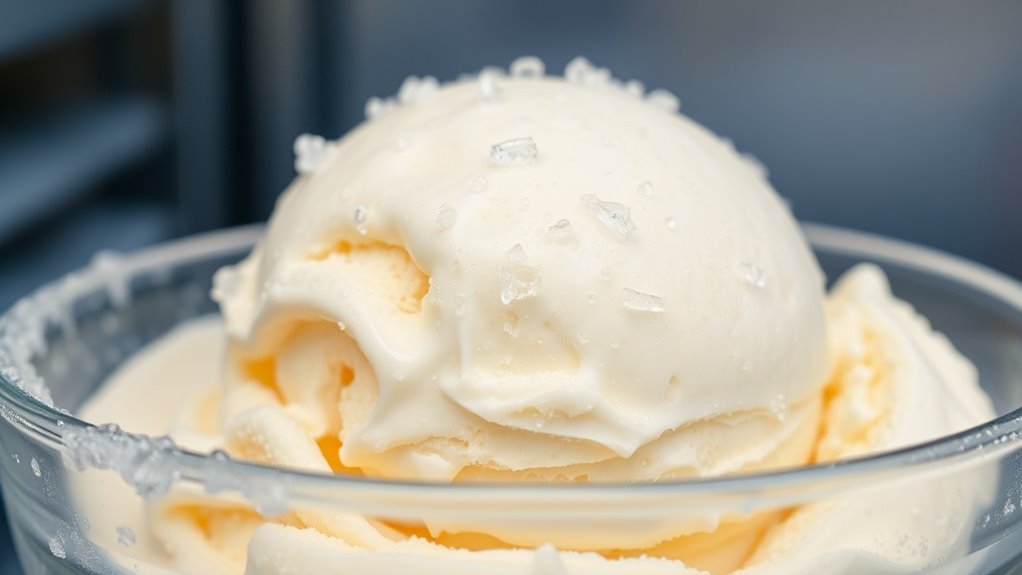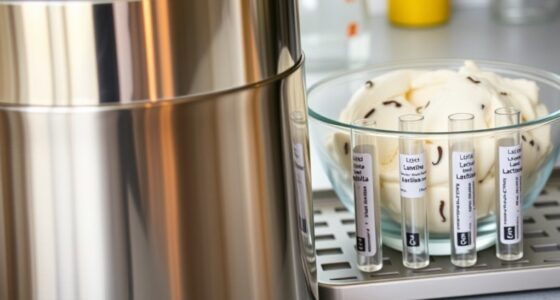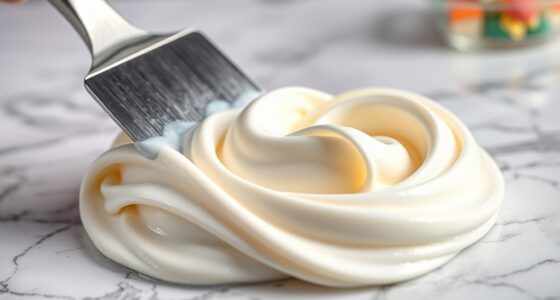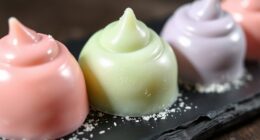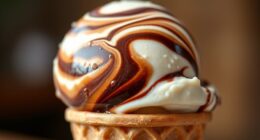When you freeze ice cream, you cool its liquid ingredients below their freezing point, causing tiny ice crystals to form. As it gets colder, these crystals grow larger without constant movement, which can make the texture grainy. Constantly churning the mixture helps keep the crystals small and distributes them evenly, making the ice cream smooth and creamy. If you want to learn more about this cooling process, keep exploring what makes ice cream perfect.
Key Takeaways
- Ice cream starts as a liquid mixture of milk, cream, sugar, and flavorings that freezes at colder temperatures.
- Sugar lowers the freezing point, requiring temperatures below 0°C to turn the mixture into ice cream.
- As it cools, tiny ice crystals form; slow freezing makes large crystals, resulting in a grainy texture.
- Constant churning during freezing helps distribute crystals evenly, producing a smooth, creamy consistency.
- Rapid freezing creates smaller crystals, leading to a softer, more desirable ice cream texture.

Have you ever wondered how ice cream turns from a liquid mixture into the creamy, solid treat you enjoy? It all comes down to temperature effects and the freezing point. When you make ice cream, you start with a liquid base that contains milk, cream, sugar, and flavorings. At room temperature, this mixture is just that—a liquid. But as you lower the temperature, something interesting happens. The key is reaching the freezing point, which is the temperature at which the liquid begins to turn into a solid.
The freezing point of your ice cream mixture is influenced by its ingredients, especially sugar. Sugar lowers the freezing point, meaning the mixture needs to get colder than pure water to freeze. Typically, pure water freezes at 0°C (32°F), but your ice cream mixture might need to reach -4°C or even lower before it solidifies. This is why your ice cream doesn’t instantly turn solid when it hits freezing temperatures; instead, it gradually cools and begins to freeze as it approaches its specific freezing point.
Temperature effects play a crucial role in how quickly and uniformly your ice cream freezes. When the mixture is cooled below its freezing point, tiny ice crystals start to form. As the temperature continues to drop, these crystals grow larger, which affects the texture of the final product. If the mixture freezes too slowly, larger ice crystals develop, resulting in a grainy or icy texture. Conversely, rapid freezing encourages the formation of smaller crystals, giving you that smooth, creamy consistency you love.
During the freezing process, constant agitation is essential. When you churn ice cream in a machine, you’re helping to distribute the forming ice crystals evenly. This prevents them from clumping together into large, undesirable chunks. The cold environment created during churning ensures that the mixture remains close to its freezing point, allowing for controlled crystal growth. This process is why homemade ice cream often turns out smoother compared to just freezing the mixture without agitation.
Frequently Asked Questions
What Ingredients Affect How Quickly Ice Cream Freezes?
You wonder what ingredients affect how quickly ice cream freezes. Ingredient effects like sugar, fat, and stabilizers play a role; sugar lowers freezing points, slowing the process, while fats and stabilizers influence texture and freezing speed. Mixing techniques also matter—stirring regularly helps distribute ingredients evenly, promoting quicker freezing. To control the process, adjust ingredient ratios and use proper mixing, ensuring your ice cream freezes just right without becoming too icy or too soft.
How Does the Temperature of the Freezer Impact Freezing?
Your freezer temperature directly affects the freezing speed of ice cream. When you set it colder, the freezing process happens faster because the heat is removed more quickly. Conversely, a warmer freezer slows down freezing, which can lead to larger ice crystals and a less smooth texture. To get your ice cream frozen just right, keep your freezer at the ideal temperature for quick and even freezing.
Why Does Ice Cream Sometimes Develop Ice Crystals?
You might notice ice cream develops ice crystals, which cause texture changes and flavor loss. When ice cream sits too long or isn’t stored properly, water molecules form larger crystals, making it gritty and less creamy. Frequent temperature fluctuations also promote crystal growth. To keep your ice cream smooth and flavorful, store it at a consistent, cold temperature and avoid thawing and refreezing.
Can Adding Alcohol Change the Freezing Point of Ice Cream?
Adding alcohol alters alcohol’s freezing point, making it lower than water’s. When you mix alcohol into ice cream, it can soften the texture and prevent ice crystals from forming. This clever concoction creates a smoother, silkier scoop. So, by balancing alcohol’s freezing point, you influence ice cream’s texture, ensuring it stays softer and less icy, perfect for a luscious, luxurious treat that’s both cool and creamy.
How Do Different Types of Ice Cream Freeze Differently?
You notice that different ice creams freeze differently because of their ingredients. For example, higher fat or sugar content influences ice crystal formation, making some ice creams smoother and creamier. These variations also help with flavor preservation, preventing ice crystals from becoming too large. So, your favorite gelato might freeze faster and stay creamier than a standard scoop, thanks to its unique recipe that affects how it freezes.
Conclusion
Now that you know how ice cream freezes, you might think it’s too complicated to make at home. But don’t worry! With a little patience and the right ingredients, you can create your own delicious frozen treat. Remember, even if your first batch isn’t perfect, you’ll learn and improve each time. So go ahead, experiment, and enjoy the sweet reward of homemade ice cream—no fancy equipment required!
